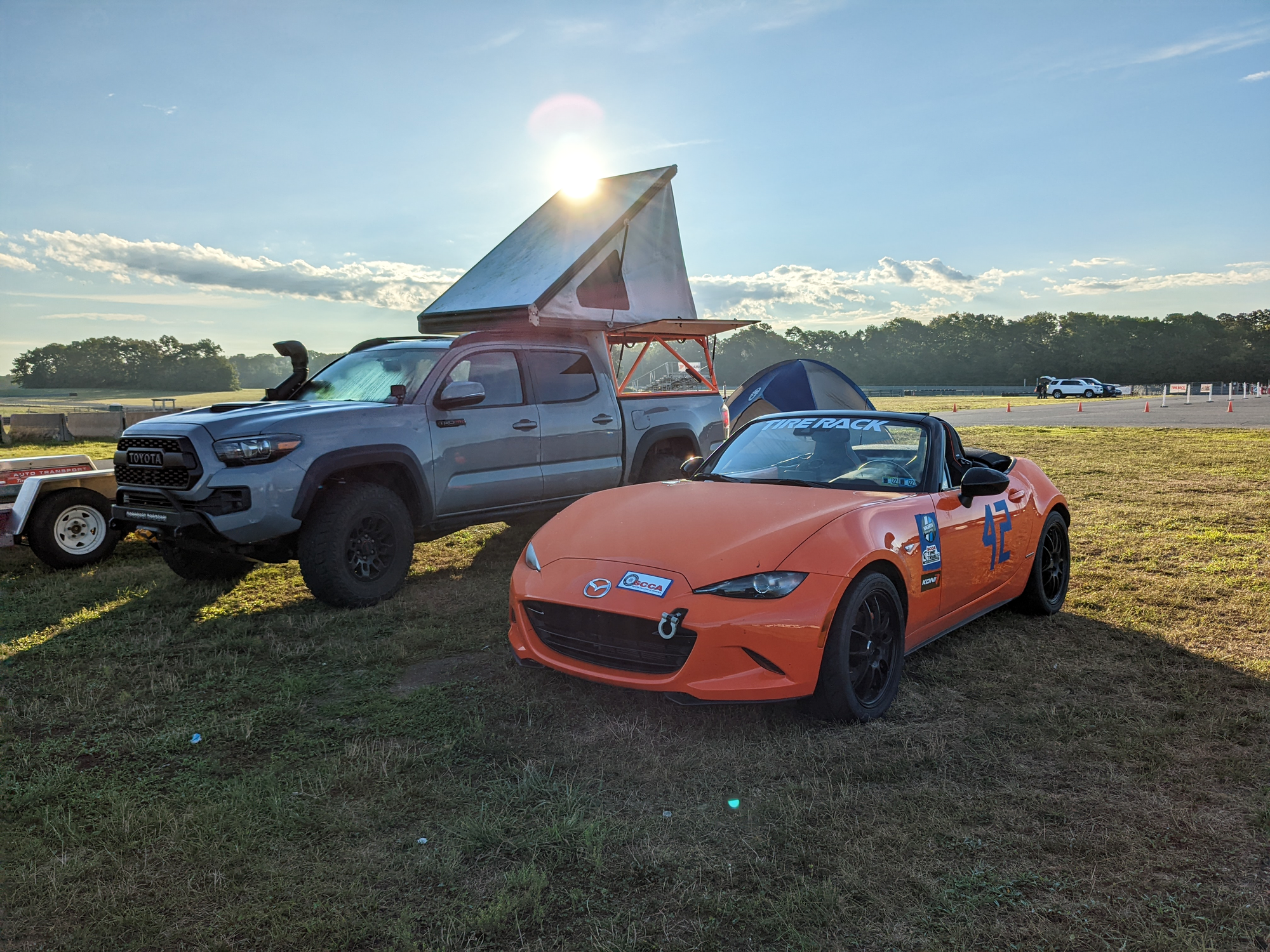Last weekend was a hot one. On Sunday the thermometer was over 90º imperial (that's 32.2ºC for you Bonaparte fans). It was also the SCCA Time Trials National Tour at Lightning, at the NJ Motorsports Park.
For a while now I've been more interested in track days than autocross, having decided that the latter, while fun, doesn't provide enough driving time for the overall time spent in the event. HPDEs (High Performance Driver Education) are a lot better in that regard, with three to five usually 20-minute long sessions in a single day. Time trials take this one step further and do four sessions a day, in a two-day event.
Time trials are also interesting because they are about competition. With all the published times available, it tells you how well you are doing, how you compare to similar cars, etc. It's a good way to help understand where you can get better. That's a part that I miss from autocross, except that the getting better part is trickier when you only have three to five 30s-40s runs [yes, seconds], and you'll never see that course again. It's an adaptation challenge on top of the driving fast challenge. But anyways, this isn't a track vs. autocross comparison. I've done one of those before.
This was my first time at a TT event. I have been at five or six HPDE events to date, including one at Lightning, where this TT took place. NJMP is only about 1.5 hrs away from my home. So having a TT national tour event right in my backyard was hard to pass up.
The two-day schedule was split into four sessions each day. The first two sessions on Saturday were for practice, and also to set the starting grid. Hm. I feel that a bit of explaining is in order.
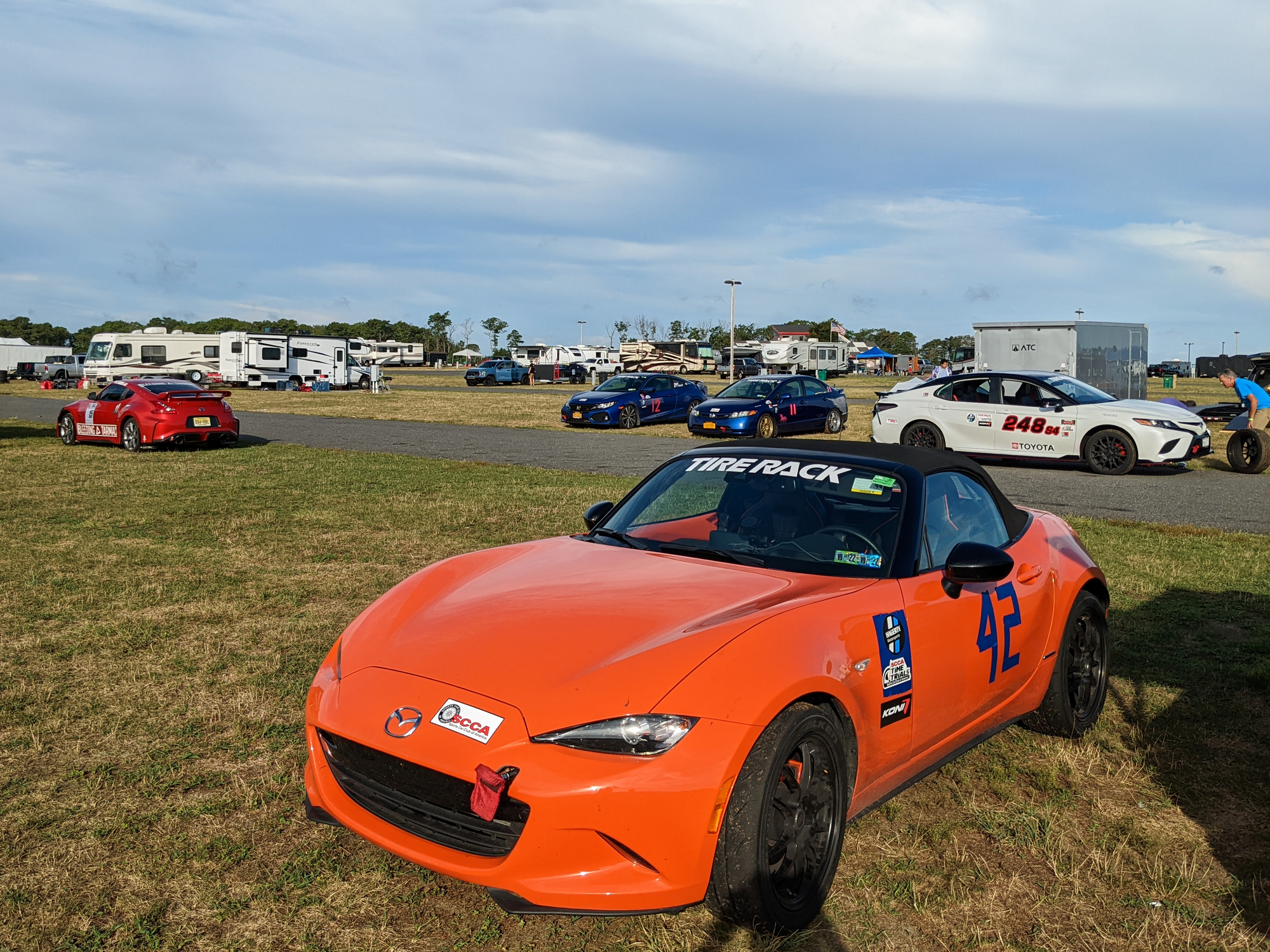
So, What's Time Trials Anyway?
We all want to race (I mean, those of us reading this, at least. Probably.). But racing is hard. Things can go wrong if you let 20 novice drivers in a closed circuit and let them engage each other in wheel-to-wheel racing. That's where time trials come in. Like in autocross, you're racing against the clock. Set your best time, and hope that you're faster than your competitors. You're still on the same track with 19 other novice drivers, but there's not necessarily a need to pass anyone to score better. Oh, and passing can only be done by "point-by," in which the slower driver makes a (polite) hand signal indicating which side of the track the passing driver should take to pass. Without the point-by, the faster driver is not supposed to pass at all. That keeps things a bit more predictable and safe.
But this sort of event is also multi-class, i.e., at any given time on the track you may have very fast cars (in the green group I was running with there were a Porsche GT3 and a Nissan GTR, for example, plus a couple of corvettes, and some other high HP vehicles) and very slow cars (like miatas, and MR2s). The lap times in our group were in the 1m15s to 1m35s range, which is a lot of variability when it comes to lap times. To avoid constantly having to yield to traffic or having to wait for traffic to yield, we have grid positions. Based on how fast you were in the average of your previous sessions, or even based on your track behavior (yellow corvette driver mentioned in my video was basically pushed out of the way to last in grid, for example) you will be assigned a starting position in the group. Fastest first. That creates more room and the chance to set a quick lap or two before you see any traffic.
To get an even better chance at a clean run the organizers divide the 20-driver group into two, and each sub-group now has half the cars, but also half the time. In a ten-minute session you can comfortably run three hot laps before having to come back in. And they should have no traffic.
Finally, your event score is the sum of your three best times in three different pairs of sessions (stay with me): On Saturday we had two practice sessions (times only for grid), two time attack sessions (pair one), good for one best time. Then, on Sunday, two more pairs of time attack sessions, good for two more best times. If you miss sessions you're desqualified.
Roughing It
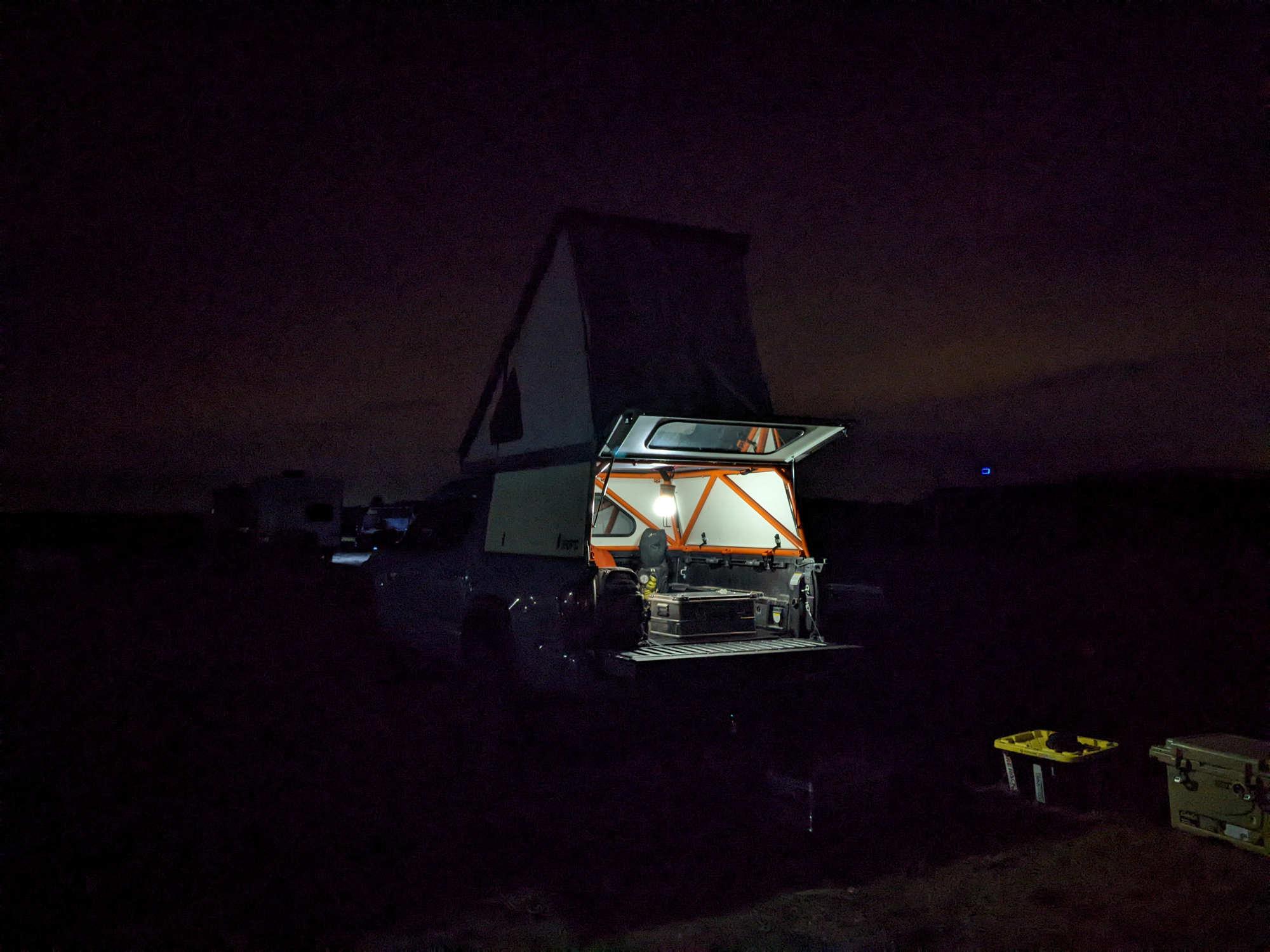
For this event I brought a pit crew! My good friend Rob decided he'd like to hang out at the track for the weekend. It was great! It was also not that great because of the heat, and because we decided to camp at the track. Trying to sleep when it's 78ºF/25.6ºC and there's some dude with a loud generator going all night long just down the camping area can be a challenge. And it was. But the roughing it was also part of the fun. I think.
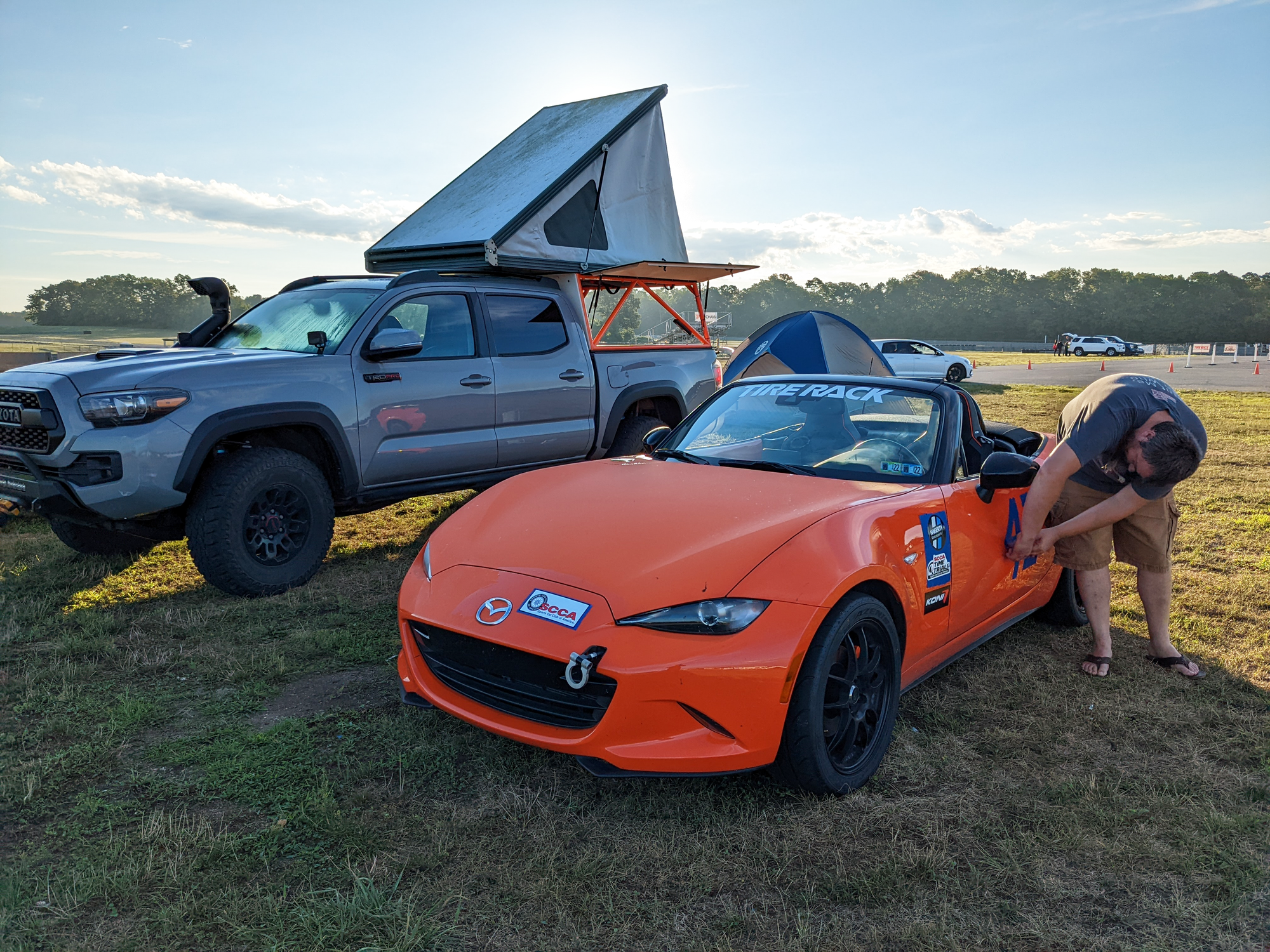
Nick (a.k.a., Dr. Nemesis, and driver of the red miata you see in videos I took that weekend) was also there hanging out at our campsite most of the time. Events like these are a lot better with friends!
Lessons
Get Serious
The biggest lesson I learned from this weekend was that I need to take things more seriously. Driver improvement and equipment improvement. I was running alone in my class, Sport 5, but Sport 6, the slower class, had plenty of drivers. The way classing works is by assigning similar cars to a class, and allowing for a certain number of changes to the car (some times of suspension mods, wider tires, tuning, etc.). My car has practically none of those changes. So I'll play that card, and say that as a momentum car (i.e., low HP) a miata needs handlig above all else to get to the fast times. But still, being only halfway the field in the slower class stings a bit.
But reviewing my video and track data I can see where I left time on the table. I think the secret to fast lap times at Lightning for a momentum car, other than the 2-3-4 turn complex, is turn 9 (a.k.a., the "lightbulb", or the "bowl"). Before starting your hot lap, a fast turn 9 allows the most speed on exit, which will be carried through the long straight, the highest speed section. Long turns like these offer a lot of opportunities for time gain/loss, and being right before the straight magnifies this effect in the case of the bowl.
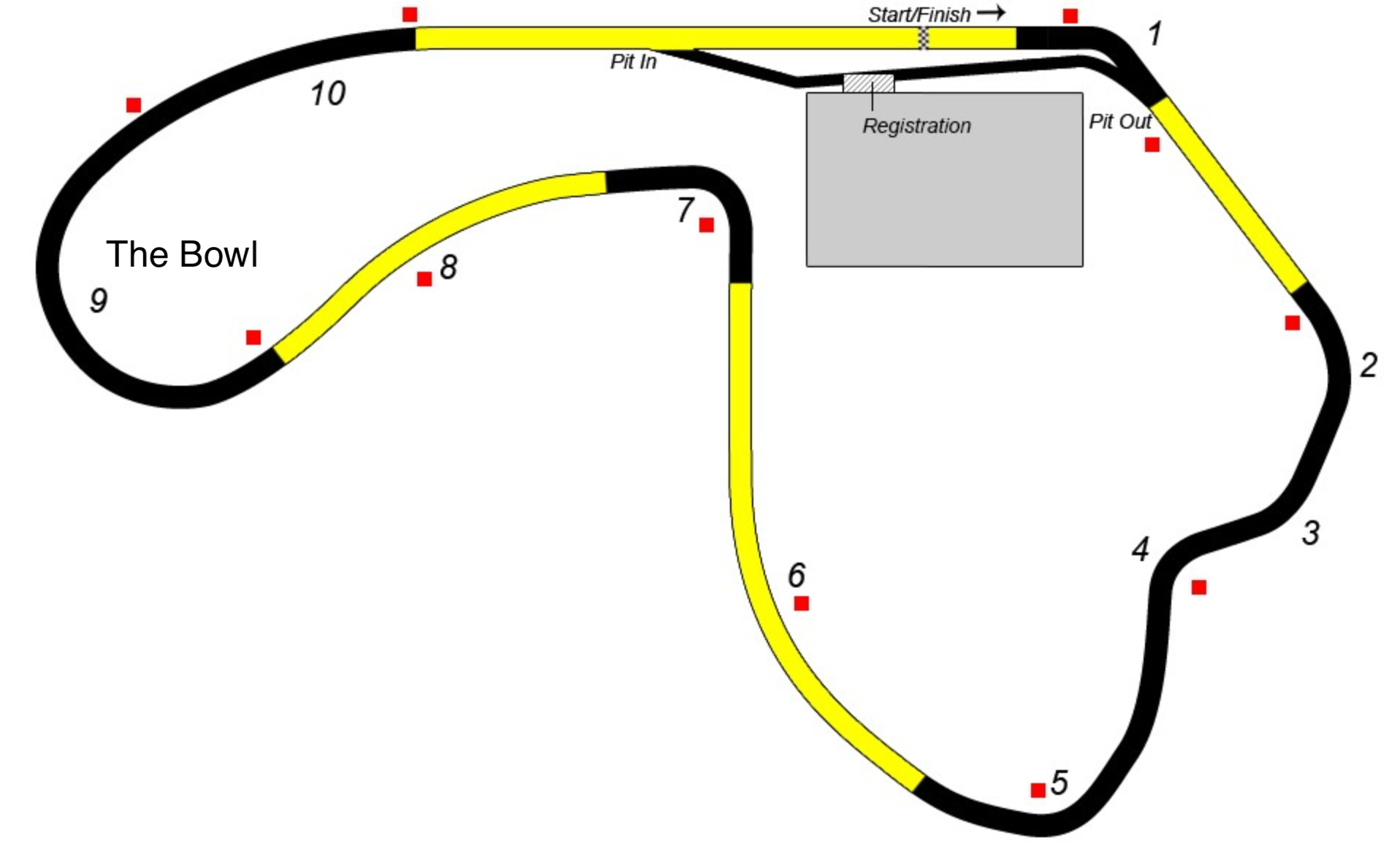
Similary in turn 5, also with a long high-speed section right after it. But turn 5 at least has an obvious racing line (basically, you just need guts!). I think turn 9 is the hardest because it's a longer turn and because of the wall which seems uncomfortably close to the outside of it (guts come into play again).
Other then guts (self-confidence), corner speeds are a matter of confidence in the car. That's a part of the equation that I feel I'm still missing. The stock miata suspension produces a lot of body roll, which disturbs the car (and the driver) on hard turns. The stock height also limits the amount of camber that can be added to the alignment. On turn 9 I was starting to feel understeer as I went through turn 9. That, and the wall, gave me pause there.
No drivers trying to be competitive will fail to take advantage of the mod allowance for their class. So part of taking things more seriously means that I'm going to make suspension changes to the car. I've been hesitant to change my suspension because I drive my MX-5 off track, in backroads and such, and love the way the ride feels. On the other hand, the max allowance in Sport 5 is not really radical. The car should still be very good on street driving. We'll see.
Get Serious, Part II: Maintenance
I was astonished by a weird noise from the left rear tire on braking, when driving to work after the TT weekend. I thought for sure I had warped a rotor. Upon inspection, I realized that the rear pads were down to the bare metal.
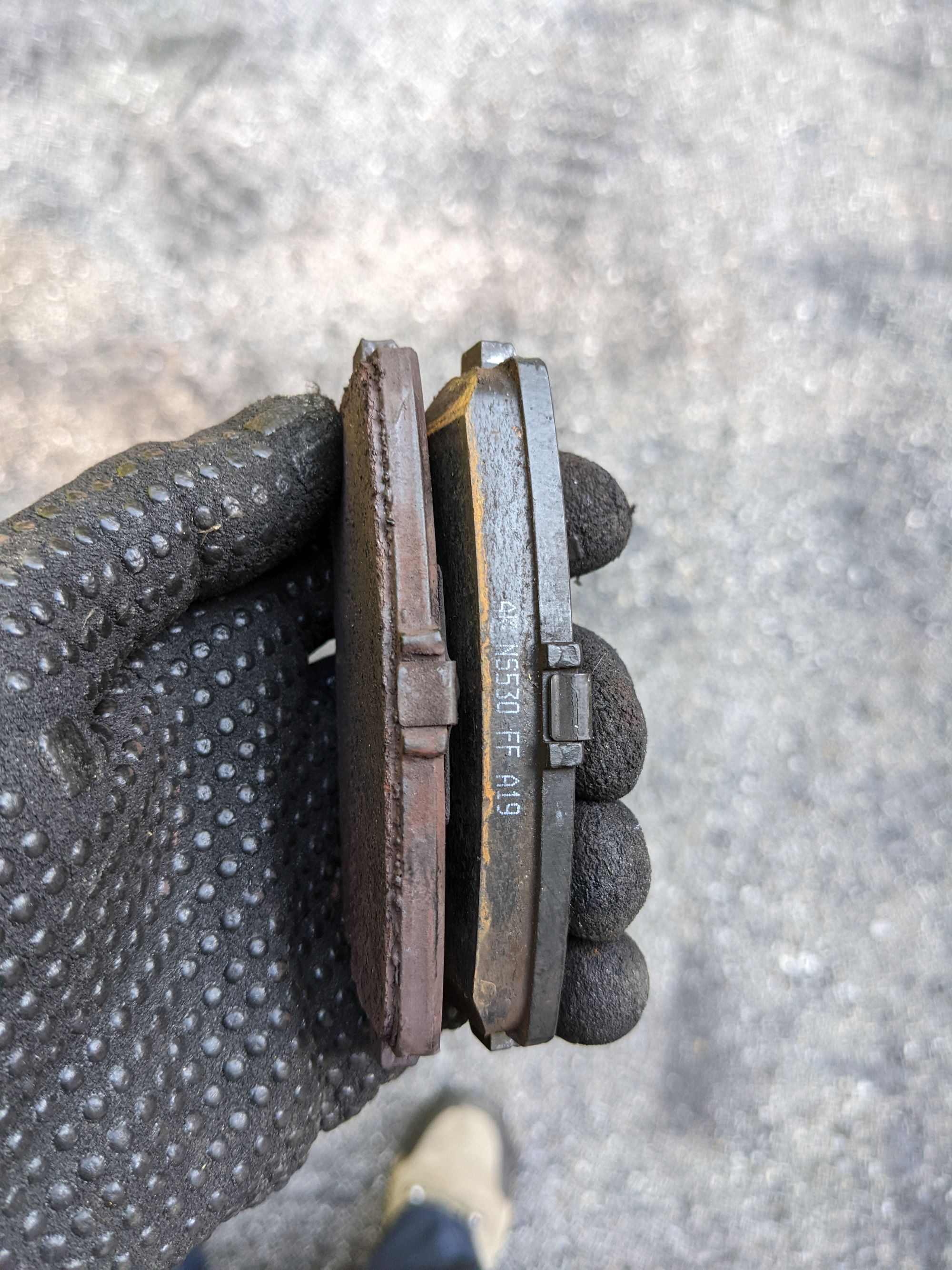
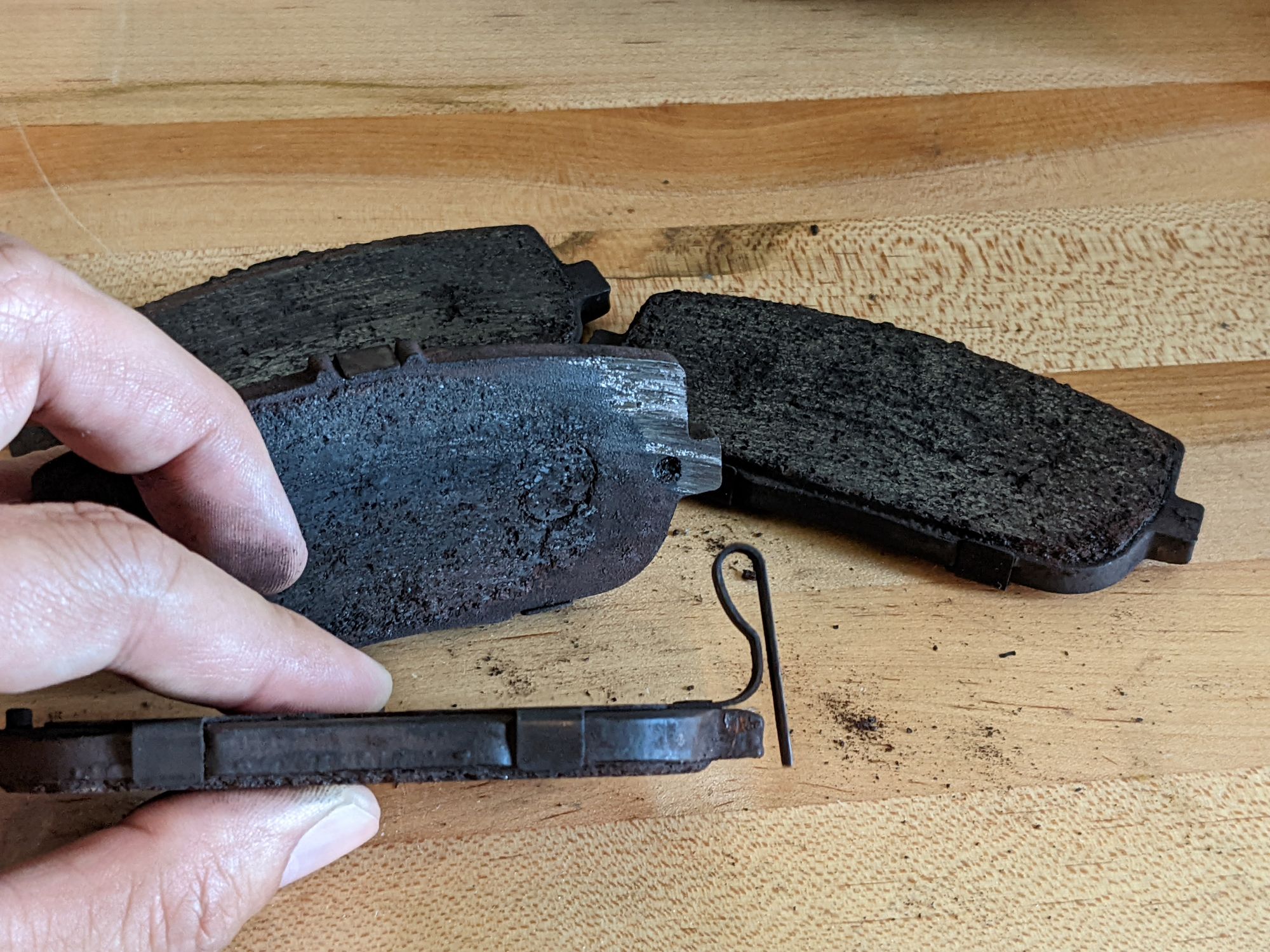
In and of itself, seems fair for the number of track days these pads went through. I should not have ran them like that in an event though. I did it because I inspected the front pads instead (easier to see with the tire off, wihouth needing to take the pads out), and seeing how much materials they had, and knowing that front pads are supposed to wear first, I did not bother to inspect the rears.
However, had I botherered on removing the front pads for inspection I would have noticed that they looked shiny, besides unaturally unworn. Which means that I managed to glaze them - impressive on Pagid R01 pads, no idea how I managed that. In any case, my front brakes have been doing much less braking than they should, as the rear pads bear witness to. To be fast you gotta be able to brake hard. Not to mention the safety concern.
So, add thorough brake inspection before/after each track event.
Learn Your Gear
I've had the chance the try my new AIM Solo 2 Data Logger on track for the first time. But I could not make good use of it because I hadn't practiced using the race analysis package that comes with it (RaceStudio3). After arriving home and running everything together I realized how useful it would have been to have used it while between sessions. I would have realized that I was able to land 1.4 Gs on sharp turns (like turn 7), but was only going to 1.2 or 1.3 on turn 5, for example. Or is it better to shift up to 5th gear towards the end of the main straight, or to stay on 4th and bounce off the rev limiter? I would have been able to compare the best sections between my good laps, and understand what speeds and braking points to target in the next session.
RaceStudio is not the friendliest analysis package, but it does have evertyhing you need, if in a less than convenient interface. It requires some practice to get the best info out of it. And I should have had that practice before the event. I should have spent more time on that than on figuring out my video/audio recording gear.
And, speaking of video gear, how the F do you fully turn off motion correction in the GoPro Hero 8? Highly annoying panning action on turns is highly annoying.
So, What's Next?
I have ordered a new set of sway bars to try to reduce body roll. These will be much stiffer than the stock bars, and are also adjustable. It will be interesting to see how my lap times on these will compare with the stocks when I go to previoulsy visited tracks. Also, I should probably update the cost tracker page...
As far as events go, the only thing in the schedule right now is an HPDE at Summit Point in September. But maybe another TT is in the cards for this year.
My adventures with data loggers and race timers that led me to the Aim Solo 2 DL might be worth an article as well. In my abundant spare time.

